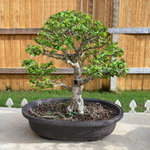I think a tidying-up could do wonders to make it a lot more compact. Applying the general Rules of Bonsai, especially reducing the top of the canopy back to one pair of leaves now, (knowing that growth is apical dominate and the top will grow more than elsewhere, up, regardless of what else happens). The lower section needs more leaves than the top and whenever the the balance shifts, the static growth on the lower levels will be exaggerated by not replacing leaves that are lost while the top canopy grows like crazy. Along with a general re-shaping to a more rounded profile and making the new canopy a helmet with the lower skirt the widest point and then tumblehome increasing as it rises to a nice round top. Only tipping all the tips on the lower branches (after shortening to the finish design length) so as to keep as many twigs and leaves down there and to ramify, too. The number of leaves on each succeeding level of branches is not optional, if you want to
keep lower branches fully foliated. My vision for the tree may differ from others...
View attachment 376008
Naturally, repositioning some minor branches with guy wires to
accentuate adjacent major branches instead of foiling the view, and removing those that don't play nice with others can make some open space for the birdies to fly through and create the irregularity that mimics real trees in nature so as to avoid looking like a plastic imitation with a too-perfect canopy.





 20180517_141509
20180517_141509




